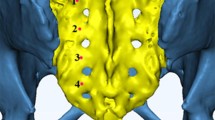Abstract
Purpose
S1 alar iliac (S1AI) trajectory has gained popularity as a salvage technique for revision surgeries and failed constructs in the lumbopelvic region. This study aims to investigate the morphometry of this new trajectory based on 3D models. The possible role of gender, ethnicity and view angle (surgeon’s vs. radiologist’s) was investigated.
Methods
Computed tomography-driven virtual 3D models of spinopelvic region were created applying Materialize MIMICS software, and assessed for coronal and sagittal radiographic versus surgeon’s view angles, and morphometry of the screw trajectory. Independent-samples t test was used to analyze the results. P value was set at < = 0.05. The Statistical Package for the Social Sciences Software (SPSS version 24.0) was used for the statistical analysis.
Results
A total of 164 3D models were simulated with a total 328 screws inserted satisfactorily within the S1AI trajectory. S1AI instrumentation was feasible in 96.48%. The mean radiological coronal angle was 50.619' ± 8.590' and the mean coronal angle for surgeons’ perspective was 10.263' ± 5.860'. The mean radiological and surgeon’s perspective sagittal angles were found to be 44.532' ± 6.424' and 31.164' ± 5.455', respectively. A statistically significant difference was found between anatomical and surgeon’s perspective trajectories. Neither the pelvic laterality nor the gender influence the screw angles, length and diameter in radiological versus surgeon’s view angles.
Conclusion
Preoperative 3D modeling would be an invaluable adjunct to increase the accuracy of S1AI screw placement. Surgeon’s perspective of the trajectory differs from standard CT sections and should be considered in preoperative planning.




Similar content being viewed by others
References
Allen BL Jr, Ferguson RL (1982) The galveston technique for L rod instrumentation of the scoliotic spine (Phila Pa 1976). Spine 7(3):276–284. https://doi.org/10.1097/00007632-198205000-00014
McCord DH, Cunningham BW, Shono Y, Myers JJ, McAfee PC (1992) Biomechanical analysis of lumbosacral fixation. Spine 17(8 Suppl):S235-243. https://doi.org/10.1097/00007632-199208001-00004
Harrop JS, Jeyamohan SB, Sharan A, Ratliff J, Vaccaro AR (2009) Iliac bolt fixation: an anatomic approach. J Spinal Disord Tech 22(8):541–544. https://doi.org/10.1097/bsd.0b013e31818da3e2
Sponseller PD, Zimmerman RM, Ko PS, Ter Gunne AFP, Mohamed AS, Chang TL, Kebaish KM (2010) Low profile pelvic fixation with the sacral alar iliac technique in the pediatric population improves results at two-year minimum follow-up. Spine 35(20):1887–1892. https://doi.org/10.1097/BRS.0b013e3181e03881
O’Brien JR, Yu WD, Bhatnagar R, Sponseller P, Kebaish KM (2009) An anatomic study of the S2 iliac technique for lumbopelvic screw placement. Spine 34(12):E439-442. https://doi.org/10.1097/BRS.0b013e3181a4e3e4
DePasse JM, Valdes M, Palumbo MA, Daniels AH, Eberson CP (2018) S-1 alar/iliac screw technique for spinopelvic fixation. J Neurosurg Spine 28(5):543–547. https://doi.org/10.3171/2017.8.SPINE16904
Kwan MK, Jeffry A, Chan CY, Saw LB (2012) A radiological evaluation of the morphometry and safety of S1, S2 and S2-ilium screws in the Asian population using three dimensional computed tomography scan: an analysis of 180 pelvis. Surg Radiol Anat 34(3):217–227. https://doi.org/10.1007/s00276-011-0919-2
Mattei TA, Fassett DR (2013) Combined S-1 and S-2 sacral alar-iliac screws as a salvage technique for pelvic fixation after pseudarthrosis and lumbosacropelvic instability: technical note. J Neurosurg Spine 19(3):321–330. https://doi.org/10.3171/2013.5.SPINE121118
Wang Z, Boubez G, Shedid D, Yuh SJ, Sebaaly A (2018) Is S1 Alar Iliac screw a feasible option for lumbosacral fixation?: a technical note. Asian Spine 12(4):749–753. https://doi.org/10.31616/asj.2018.12.4.749
Wu AM, Chi YL, Ni WF, Huang YX (2016) The feasibility and radiological features of sacral alar iliac fixation in an adult population: a 3D imaging study. Peer J 4:e1587. https://doi.org/10.7717/peerj.1587
Wang Y, Hu W, Hu F, Zhang H, Wang T, Wang Y, Zhang X (2018) Proper detailed parameters for S1 sacral alar iliac screw placement in the Chinese population, a 3D imaging study. J Orthop Surg Res 13(1):39. https://doi.org/10.1186/s13018-018-0739-8
Gardner MJ, Morshed S, Nork SE, Ricci WM, ChipRoutt ML Jr (2010) Quantification of the upper and second sacral segment safe zones in normal and dysmorphic sacra. J Orthop Trauma 24(10):622–629. https://doi.org/10.1097/BOT.0b013e3181cf0404
Celestre PC, Dimar JR 2nd, Glassman SD (2018) Spinopelvic parameters: lumbar lordosis, pelvic incidence, pelvic tilt, and sacral slope: what does a spine surgeon need to know to plan a lumbar deformity correction? Neurosurg Clin N Am 29(3):323–329. https://doi.org/10.1016/j.nec.2018.03.003
Hu W, Zhang X, Yu J, Hu F, Zhang H, Wang Y (2018) Vertebral column decancellation in Pott’s deformity: use of Surgimap spine for preoperative surgical planning, retrospective review of 18 patients. BMC Musculoskelet Disord 19(1):13. https://doi.org/10.1186/s12891-018-1929-6
Akbar M, Terran J, Ames CP, Lafage V, Schwab F (2013) Use of Surgimap Spine in sagittal plane analysis, osteotomy planning, and correction calculation. Neurosurg Clin N Am 24(2):163–172. https://doi.org/10.1016/j.nec.2012.12.007. (PMID: 23561555)
Acknowledgements
This study was partially founded by the “Vice Chancellor of Research of Islamic Azad University of Medical Sciences.”
Funding
The authors declare that they have no financial interests.
Author information
Authors and Affiliations
Corresponding author
Ethics declarations
Conflict of Interest
The authors declare no conflict of interest.
Ethical approval
Approval was obtained from the ethics committee of Islamic Azad University of Medical Sciences (IR.IAU.PS.REC1399.066). The procedures used in this study adhere to the tenets of the Declaration of Helsinki.
Additional information
Publisher's Note
Springer Nature remains neutral with regard to jurisdictional claims in published maps and institutional affiliations.
Rights and permissions
Springer Nature or its licensor (e.g. a society or other partner) holds exclusive rights to this article under a publishing agreement with the author(s) or other rightsholder(s); author self-archiving of the accepted manuscript version of this article is solely governed by the terms of such publishing agreement and applicable law.
About this article
Cite this article
Vahedi, P., Shabakhsh, G. & Monji, F. Software-assisted preoperative planning of S1 Alar Iliac screws: a 3D morphometric and anatomical study. Eur Spine J 32, 2274–2281 (2023). https://doi.org/10.1007/s00586-023-07741-1
Received:
Revised:
Accepted:
Published:
Issue Date:
DOI: https://doi.org/10.1007/s00586-023-07741-1




